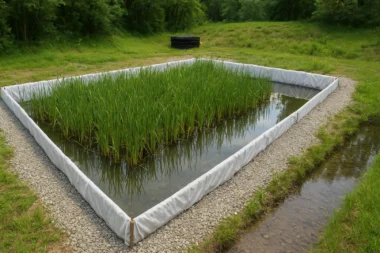Introduction
An electrocoagulation system is a water treatment technology that uses electrochemical reactions to remove contaminants from water. It is commonly used to remove suspended solids, colloidal particles, metals, organic compounds, and specific pollutants. The system works by destabilizing and agglomerating the contaminants, forming larger particles that can be easily separated from the water.
Architecture of an electrocoagulation system
The architecture of an electrocoagulation system can vary depending on the specific design and application requirements. However, a typical electrocoagulation system consists of the following components:
- Electrodes: The system includes two or more electrodes made of conductive materials, such as iron, aluminum, or other metals. The electrodes are typically arranged parallel to each other and spaced apart within the treatment unit.
- Power Supply: An external power supply, such as a rectifier, provides the electrode’s direct current (DC). The power supply controls the voltage and current applied to the electrodes, influencing the electrochemical reactions and the production of coagulants.
- Electrolysis Chamber: The electrolysis chamber is the main component where the electrochemical reactions occur. It houses the electrodes and provides a controlled environment for the electrocoagulation process.
- Flow Control System: In water treatment applications, the system often includes a flow control system to regulate water flow rate through the electrolysis chamber. This ensures sufficient contact time between the water and the electrodes for effective electrocoagulation.
- pH Adjustment System: In some cases, a pH adjustment system is incorporated to control the pH of the water. It may involve adding chemicals or using pH adjustment devices to optimize electrocoagulation.
- Settling or Flotation Tank: After electrocoagulation, a settling or flotation tank may be included in the system. This tank allows the treated water to sink or float, facilitating the separation of the agglomerated particles or flocs from the clarified water.
- Control and Monitoring System: An electrocoagulation system may feature a control and monitoring system to regulate and monitor parameters such as voltage, current, pH, flow rate, and other operational parameters. This system ensures proper optimization and efficient operation of the electrocoagulation process.
- Sludge Disposal System: Electrocoagulation can generate sludge or sediments due to the coagulation and settling processes. A sludge disposal system, such as a sludge collection and dewatering unit, may be incorporated to handle and dispose of the generated sludge appropriately.
The specific arrangement and configuration of these components can vary based on the scale of the electrocoagulation system, the application requirements, and the desired treatment objectives. The architecture of the electrocoagulation system is designed to facilitate efficient electrolysis, coagulant production, particle destabilization, and subsequent separation processes to achieve effective water treatment.
Process of electrocoagulation
- Electrodes: The system consists of two or more electrodes, typically made of metal, such as iron or aluminum. One electrode acts as an anode (positive electrode), and the other acts as a cathode (negative electrode). The selection of electrode materials depends on the type of contaminants to be treated.
- Electrolysis: When an electric current is applied to the electrodes, electrolysis occurs. The anode releases metal ions (e.g., Fe²⁺ or Al³⁺) into the water, while the cathode generates hydroxide ions (OH⁻). The cast metal and hydroxide ions play a crucial role in coagulation.
- Coagulation: The metal ions produced at the anode and the hydroxide ions generated at the cathode form metal-hydroxide complexes. These complexes act as coagulants and destabilize the suspended particles and colloidal contaminants present in the water.
- Agglomeration: As the metal hydroxide complexes form, they adsorb onto the surface of the suspended particles, organic compounds, and other contaminants. This process neutralizes the surface charges of the pollutants and promotes their agglomeration or flocculation.
- Settling or flotation: The agglomerated particles and contaminants form larger flocs that settle to the bottom of the treatment tank or float to the water surface, depending on their density. Depending on the specific design of the electrocoagulation system, sedimentation or flotation processes are used to separate the flocs from the clarified water.
- Separation: Once the flocs have settled or floated, they can be separated from the treated water using physical separation methods such as sedimentation, filtration, dissolved air flotation (DAF), or other appropriate techniques.
Destabilizing and agglomerating the contaminants, forming larger particles that can be easily separated from the water.
Destabilizing and agglomerating contaminants refers to causing the water’s suspended particles or colloidal substances to come together and form larger particles or flocs. These larger particles are then easily separated from the water through sedimentation, flotation, or filtration processes. Here’s an explanation of how this process works:
- Destabilization: The first step is to destabilize the contaminants present in the water. Adding coagulants, such as alum or ferric chloride, is a common way to accomplish this in conventional coagulation processes. The coagulants neutralize the electrical charges on the particles, which are often negatively charged, reducing the repulsive forces between them.
- Collision and Attachment: Once the particles are destabilized, they can move closer to each other due to the reduced repulsive forces. This movement allows the particles to collide and attach. The agitation or mixing of the water may aid in the collisions by encouraging particle contact.
- Agglomeration: As the particles collide and attach, they form aggregates or agglomerates. The agglomerates continue to grow in size as more particles join the structure. Adding flocculants, chemicals that help bind the particles together, frequently facilitates this process.
- Floc Formation: The accumulation of particles leads to the formation of larger particles called flocs. Flocs are networks of particles held together by physical or chemical interactions. The size and strength of the flocs depend on various factors, such as the characteristics of the particles, the nature of the coagulants or flocculants used, and the mixing conditions.
- Separation: Once the flocs have formed, they can be easily separated from the water using different separation techniques. Sedimentation is a standard method where the water remains undisturbed, causing the heavier flocs to settle to the bottom of a tank or basin. Flotation processes involve the introduction of air or gas bubbles, which attach to the flocs and cause them to float to the water’s surface. Filtration methods include passing the water through a filter media that retains the larger flocs while allowing the clean water to pass through.
The destabilization and agglomeration processes aim to transform the finely suspended particles or colloidal matter into larger, more easily removable entities. By forming larger particles, or flocs, water treatment processes can effectively separate and remove contaminants, improving the overall quality of the water.
How does electrocoagulation use electric fields to destabilize suspended particles in water?
Electrocoagulation uses electric fields to destabilize suspended particles in water through a process called electrophoresis and coagulation. Here’s how it works:
- Electrophoresis: When an electric current is applied to the electrodes in an electrocoagulation system, an electric field is generated in the water. The electric field induces electrophoresis, where charged particles in the water experience a force and migrate toward the oppositely charged electrode.
- Particle Destabilisation: The electric field causes the charged particles in the water, such as suspended solids, colloidal particles, and microorganisms, to move toward the electrodes. This movement disrupts the stability of the particles by overcoming the repulsive forces between them.
- Coagulation: As the charged particles move closer to the electrodes, they interact with other particles and ions in the water. The electrochemical reactions at the electrodes produce metal ions (e.g., Fe²⁺ or Al³⁺) and hydroxide ions (OH⁻). These ions act as coagulants.
- Coagulant Formation: The metal ions released at the anode and the hydroxide ions generated at the cathode combine in the water to form metal hydroxide complexes. These complexes act as coagulants and further contribute to destabilizing the suspended particles.
- Particle Agglomeration: The coagulants, which are metal hydroxide complexes, stick to the surfaces of the suspended particles, colloidal particles, and organic compounds in the water. This neutralizes the surface charges of the particles and promotes their agglomeration or flocculation.
- Settling or flotation: The agglomerated particles form larger flocs that can settle to the bottom of the treatment tank or float to the water surface, depending on their density. The flocs carry the contaminants, including suspended particles and colloidal substances.
- Separation: Once the flocs have settled or floated, they can be separated from the treated water using physical separation methods such as sedimentation, filtration, or dissolved air flotation (DAF). These techniques help to remove the coagulated particles and produce clarified water.
By applying an electric field, electrocoagulation harnesses electrophoresis to move charged particles toward the electrodes and destabilize them. The subsequent coagulation and agglomeration processes enhance the removal of suspended particles, colloidal substances, and other contaminants from water. Electrocoagulation offers an efficient and environmentally friendly method for water treatment, particularly in situations where traditional coagulation methods may be challenging or less effective.
Techniques used to destabilize suspended particles in water
There are several techniques commonly used to destabilize suspended particles in water. These techniques aim to reduce the repulsive forces between particles, allowing them to come together and form larger agglomerates that can be more easily separated from the water. Here are some of the commonly employed techniques:
- Coagulation: Coagulation involves the addition of coagulants, such as aluminum sulfate (alum) or ferric chloride, to the water. These coagulants neutralize the charges on the particles, reducing the repulsive forces and promoting particle agglomeration. Following coagulation is frequently flocculation, which uses gentle mixing to encourage the formation of larger flocs.
- pH Adjustment: Changing the pH of the water can also help with particle destabilization. The optimum pH for destabilization depends on the specific type of particles present. For example, adjusting the pH to either acidic or alkaline conditions can induce precipitation or change the surface charges of particles, leading to their accumulation.
- Electrocoagulation: As mentioned earlier, electrocoagulation uses electric fields to destabilize suspended particles. Applying an electric current induces the electrophoretic movement of particles toward the oppositely charged electrodes, leading to their destabilization and agglomeration.
- Flocculation: Flocculation is a process that involves gentle mixing or stirring to bring the destabilized particles into contact with each other, promoting their collision and agglomeration. This process helps to form larger flocs that are easier to settle or filter out of the water.
- Chemical Flocculants: Chemical flocculants, such as cationic polymers or organic polymers like polyacrylamide, can be added to the water to enhance the flocculation process. These flocculants interact with the particles, causing them to aggregate and form larger flocs.
- Sedimentation: After destabilization and flocculation, sedimentation separates the agglomerated particles from the water. In this process, the water remains undisturbed, enabling gravity to pull the larger particles or flocs downward to form sediment at the bottom of the container.
- Filtration: Filtration involves passing the water through a filter medium, such as sand, activated carbon, or membranes. The filter media physically trap and retain the suspended particles, allowing the clean water to pass through.
These techniques can be used individually or in combination, depending on the specific water treatment requirements and the nature of the suspended particles. The choice of method depends on factors such as the size and type of particles, the concentration of contaminants, the desired water quality, and the available treatment infrastructure. Proper optimization and selection of techniques are crucial to effectively and efficiently removing suspended particles in water treatment processes.
The science behind the electrocoagulation system
The science behind an electrocoagulation system lies in the electrochemical reactions at the electrodes and the subsequent coagulation process. Here’s a breakdown of the science involved:
- Electrochemical Reactions: When an electric current is passed through the electrodes in an electrocoagulation system, electrochemical reactions take place. The electrodes are typically made of iron (Fe), aluminum (Al), or other metals. These reactions depend on the type of electrode material used:
- Anode (positive electrode): At the anode, oxidation reactions occur, releasing metal ions (e.g., Fe²⁺, Al³⁺) from the electrode into the surrounding water. For example, in the case of iron electrodes, iron ions are generated:
Fe(s) → Fe²⁺(aq) + 2e⁻
- Cathode (negative electrode): At the cathode, reduction reactions take place, producing hydroxide ions (OH⁻) in the water:
2H₂O + 2e⁻ → H₂ + 2OH⁻
- Coagulant Formation: The metal ions (e.g., Fe²⁺, Al³⁺) released at the anode and the hydroxide ions (OH⁻) generated at the cathode combine in the water to form metal hydroxide complexes. These complexes act as coagulants. For example, in the case of iron electrodes, the following reaction occurs:
Fe²⁺(aq) + 2OH⁻(aq) → Fe (OH)₂(s)
The metal hydroxide complexes have a high affinity for suspended particles, colloidal matter, and dissolved contaminants in the water.
- Destabilization and Coagulation: The coagulants formed in the electrochemical reactions contribute to destabilizing suspended particles and colloidal substances in the water. The metal hydroxide complexes adsorb onto the surface of these particles, neutralizing their surface charges. As a result, the repulsive forces between particles are reduced, allowing them to come together and form larger agglomerates.
- Agglomeration and Settling: The agglomerated particles, or flocs, grow as more particles adhere to the coagulated mass. These larger particles are more easily separated from the water through settling or flotation processes. Settling occurs when the flocs become denser than the water and sink to the bottom of the treatment tank, while flotation involves the attachment of gas bubbles to the flocs, causing them to float to the water’s surface.
An electrocoagulation system effectively produces coagulants that destabilize the water’s suspended particles and colloidal matter by applying an electric current and inducing electrochemical reactions. The subsequent aggregation and separation processes allow for the removal of contaminants, leading to improved water quality. The electrochemical responses and coagulant formation depend on the electrode material used and the electrolysis conditions applied in the electrocoagulation system.
Case study
Case Study: Electrocoagulation for the Treatment of Textile Wastewater
Objective: This case study aimed to assess the effectiveness of electrocoagulation in treating textile wastewater and the removal efficiency of various contaminants.
Background: A textile manufacturing facility was experiencing challenges in treating its wastewater, which contained high levels of organic dyes, suspended solids, and chemical oxygen demand (COD). Traditional treatment methods proved inadequate, leading to environmental compliance issues and increased operational costs.
Experimental Setup:
- Electrocoagulation System: An electrocoagulation system was installed, comprising iron electrodes, a power supply, and a flow control system.
- Wastewater Source: The textile wastewater sample was collected from the facility’s effluent stream and is representative of the wastewater composition.
- Experimental Conditions: To optimize the process, the electrocoagulation system was operated at varying current densities, treatment times, and pH levels.
- Analysis: Samples were collected before and after treatment and analyzed for parameters such as color removal, turbidity reduction, suspended solids removal, and COD reduction.
Results: The electrocoagulation process demonstrated significant improvements in treating textile wastewater. Here are the key findings:
- Color and Turbidity Removal: Electrocoagulation effectively removed color from the wastewater, resulting in a noticeable reduction in the visual intensity of dyes. Additionally, there was a significant decrease in turbidity due to suspended particles, which made the water more transparent.
- Suspended Solids Removal: The electrocoagulation system efficiently removes suspended solids in the wastewater. The aggregation of particles facilitated by electrocoagulation resulted in the formation of larger flocs that settled more quickly. This led to a substantial decrease in the concentration of suspended solids.
- Chemical Oxygen Demand (COD) Reduction: Electrocoagulation demonstrated significant COD reduction in the textile wastewater. The electrochemical reactions and subsequent coagulation processes facilitated the breakdown and removal of organic compounds responsible for high COD levels.
- Sludge Generation and Management: The electrocoagulation process generated sludge as a by-product. However, the sludge exhibited improved dewaterability, reducing the overall volume and facilitating more straightforward disposal or potential recovery of valuable components.
Conclusion:
The case study highlighted the effectiveness of electrocoagulation in treating textile wastewater. The electrocoagulation system successfully removed color, turbidity, and suspended solids and reduced the chemical oxygen demand. The process provided a sustainable and cost-effective solution for the textile manufacturing facility, addressing their wastewater treatment challenges and ensuring compliance with environmental regulations.



